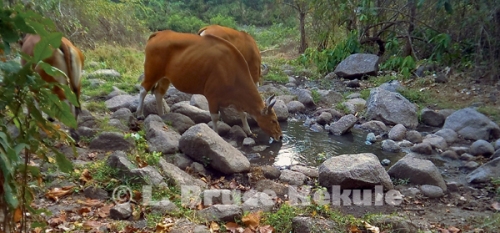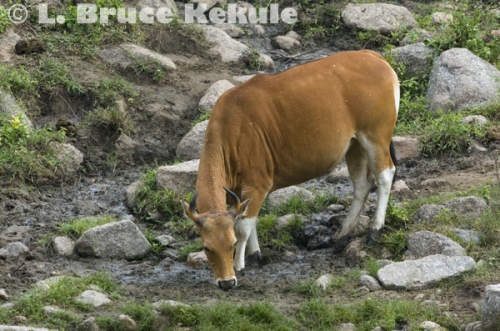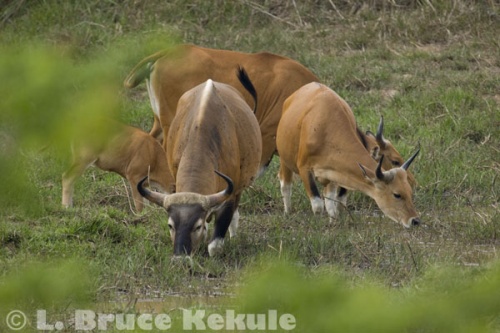Posts Tagged ‘bovid’
Banteng: Endangered Herbivores
WILD SPECIES REPORT
Banteng: Endangered herbivores
Magnificent wild cattle of Southeast Asia
Bovids threatened with extinction
It was a hot steamy morning deep in the wilderness of Huai Kha Khaeng Wildlife Sanctuary, a World Heritage Site located in the central province of Uthai Thani. Not much was stirring other than a few birds and insects as the sun rose high in the sky. A hot breeze whiffed through, and heat shimmered from the center of a natural mineral deposit several hours walk from the nearest road. As the day got hotter, thirst kicked in among the many species of herbivore that live in the forest nearby.
Banteng bull in Huai Kha Khaeng
Muntjac (barking deer), sambar, banteng and gaur use this important source of minerals. Many smaller mammals, birds, and reptiles also come to the lick as part of their everyday life. Tiger, leopard, and wild dog frequent the area in search of prey. Occasionally, wild elephant stop for a drink. A male barking deer stepped cautiously down to the water hole. Moving slowly and constantly watching out for predators, the young buck took a long-awaited sip of the life giving minerals. Shortly after, it disappeared back into the forest it had come from. Silence again took precedence as the morning wore on.
Banteng bull and cow in Huai Kha Khaeng
About an hour later at the top-end of the clearing, a herd of twelve banteng magically appeared and went straight down to the waterhole, as their kind have done for aeons. The herd included one old bull, a couple of young bulls and cows, plus three calves, and, like the deer, were extremely alert for carnivores. All of a sudden, a cow snorted an alarm, and the herd bolted for the safety of the bush. Curious by nature, the herd bull stopped short near the forest edge for one last look. The herd surrounded the bull and the young calves trailed behind before disappearing into the trees. For a moment, they were vulnerable to attack by predator. Banteng are very sensitive to any disturbance and flee immediately on the first hint of danger.
Banteng on the run in Huai Kha Khaeng
Another hour went by and suddenly, a solitary banteng bull appeared from the forest and moved down to the waterhole but stayed only momentarily. These loners usually pursue the herd during the mating season and have an irresistible urge to mate with the females. However, the herd bull will keep the young bulls in check.
The spirits of the forest had just provided a vision; some beautiful moments in the lives of banteng, Southeast Asia’s wild cattle. My friend Robert Semon and I were sitting in a photographic blind set up just inside the forest edge, but with an open view to the water hole. Banteng had been the main photographic objective on this trip, and it was magnificent seeing and photographing these wild bovids. My camera was very busy during that short period. As it was the first time I had photographed them, the encounter will be forever etched in memory.
Mature banteng bull in Huai Kha Khaeng
Coming back to Huai Kha Khaeng a couple of years later, my team erected a photo-blind while I went looking for tracks. A large granite rock sits in the middle of this oasis in the forest, so I paid my respects to the spirits of the forest thanking them for my previous good fortune here. It was about an hour’s walk back to the truck, and another hour to camp, but I was feeling lucky. After dinner, and a few drinks with the team, I retired to my hammock for an early wake-up.
The next morning I was in the blind at 6am and, after a three-hour wait, a lone banteng bull lumbered down to the waterhole for a drink. My wish had come true. After getting very close to the blind, he sensed danger and bolted. I shot several rolls of film. Alone, the bull was open to attack by tiger or wild dogs. It was very exciting photographing this beautiful creature.
A couple of years later, on one of my many forays into Huai Kha Khaeng, I decided to stay overnight in a permanent photographic blind set-up along the banks of Huai Mae Dee, a tributary of the Huai Kha Khaeng. That night as I lay in my hammock, I wished once again to see banteng. The next morning, the mist was thick as soup, coating the forest with dew. My focus was on a mineral lick across the river. Many rare species of large mammal visit this natural deposit for a drink, and a nibble on the lush grass growing on the rocky slope. A female muntjac nervously appeared, took a drink but quickly departed.
Banteng cow on the Huai Mae Dee
At about 8am, as the sun was just peaking over the treetops, a large herd of banteng stepped out into the mineral lick. There were five bulls and numerous cows and calves in this herd totaling 18 banteng, and it was an exciting ten-minute session. It was during the mating season, the reason so many bulls had come together. I was shooting a digital camera by now and did not stop photographing them until the last one had gone. As always, I gave thanks to the spirits of the forest for my good fortune.
The accompanying photographs show the beauty and gracefulness of these magnificent ungulates. Over the years, I have seen these wild cattle many times, not only in Huai Kha Khaeng (present herd estimated at over 250 individuals), but also over in Khao Ang Rue Nai Wildlife Sanctuary, eastern Thailand (about 80 banteng). These two santuaries are the last bations of a sizable banteng herd left in the Kingdom.
Banteng cows at a waterhole
Huai Kha Khaeng still retains the best prey/predator relationship with many tigers and a sizable herd of banteng plus many other ungulates like gaur, sambar and wild pig. Khao Ang Rue Nai has very few carnivores but Asian wild dogs do take banteng from time to time. Humans unfortunately, are the most devestating predator and are directly responsible for the disappearence of these wonderful creatures. Trophy hunting and bush meat are the two main reasons for this demise.
The other remaining sites that have recorded banteng but are probably now close to extirpation of the species with very few remaining are: Om Koi Wildlife Sanctuary in the North; Nam Nao and Tap Praya national parks in the Northeast; Salak Phra Wildlife Sanctuary and, Sai Yok, Sri Nakharin and Kaeng Krachan national parks in the west; Khlong Saeng and Khlong Yan wildlife sanctuaries in the south; and Sri Satchanarai National Park in the foot-hills of Central Thailand. Their present numbers are estimated to be no more than a very low 300-500 nationwide.
Fossils of an antelope-like ox named Leptobos was discovered in Early Pleistocene deposits 1.8 million years old in Eurasia. Another ancient cattle found in Europe called Bos primigenius or better known as aurochs were domesticated some 6,000 years ago but died out about 500 years ago. Banteng are common ansestors to Bos bibos, a cattle that inhibitated the vast plains of Asia during prehistoric times. Fossil finds of banteng from the Pleistocene epoch in Bali and Java are common.
Banteng herd on a sandbar in Huai Kha Khaeng
Wild banteng Bos javanicus have a scattered distribution throughout Southeast Asia, and three subspecies are recognized. The Java banteng Bos javanicus javanicus of Java and Bali, the Borneo banteng Bos javanicus lowi, and the Burma banteng Bos javanicus birmanicus, also of Thailand and Indochina. Only a few thousand wild banteng are reported to survive throughout their entire range, since human encroachment and poaching in all the above countries have exacted a heavy toll on them. Their future hangs in the balance. Thailand is no exception and the banteng population has declined drastically since World War II.
Banteng bull at a mineral lick in Huai Kha Khaeng
The Kingdom’s protected areas include national parks and wildlife sanctuaries, and are all controlled and managed by the Department of National Parks, Wildlife and Plant Conservation (DNP). It is extremely difficult defending these forests from human intervention, and the DNP has a heavy burden to bear. Let us hope that they will succeed in this very important but really tough task!
One alternative to disappearing banteng is a reintroduction program to save the species. There are a few breeding centers around the country with banteng. Unfortunately, most of the stock is Indonesian banteng. Years ago, Kukrit Pramote, Thailand’s Prime Minister using government to government relations, imported Indonesian banteng that were released at Lum Phow Non-hunting Area in Kalasin province. There are about 60 surviving on a 900 rai plot. Only one breeding center at Khao Nam Phu, Kanchanaburi province is reported to have Thai banteng. Several young banteng were taken from Salak Phra Wildlife Sanctuary next door and produced off-spring. Presently, there are about 10 individuals at Khao Nam Phu.
Banteng bull at a breeding station in Salak Phra Wildlife Sanctuary
Another pilot program started in 1991 was initiated at Khao Kheow Open Zoo and 13 banteng (unknown origin) were released to adjacent Khao Kheow-Khao Chumpu Wildlife Sanctuary (144 sq.kilometers) in Chonburi province. There are now an estimated 49 banteng surviving in this herd with a few mature bulls living in a very splintered habitat. Poachers however, are a serious threat here using pipe guns and rope snares left in the forest, and inflict casualties on these reintroduced denzins. DNP needs to make sure they are protected to the fullest.
Rare white-spotted banteng cow – endemic to Huai Kha Khaeng
Banteng have been called the most beautiful of all the wild relatives of cattle. The colouring of young bulls and cows is generally a vibrant reddish brown, though some are fawn. The old bulls in Thailand are mostly blackish-brown, but Indonesian banteng bulls are very dark brown to black in some. Regardless of sex, all Thai banteng have a white band around the muzzle, small white patches over the eyes, white stockings on all four legs, and a large white patch on the rump. Another distinct feature is a black stripe along the spine. The dorsal ridge is pronounced in the large adult bulls. Some Thai banteng have white spots along the flank, but this is not found among the other subspecies.
The skull and horns of banteng are less massive then their cousins the gaur Bos gaurus, but are nevertheless formidable weapons. They use their horns for protection, but the males also use them to decide who will get the females during the breeding season in May and June. Gestation is nine and a half to ten months, and one or two calves may be born. The calves are suckled until they are fourteen to sixteen months old.
Banteng bull and cows at a waterhole in Huai Kha Khaeng – note very dark colored bull
Banteng look very much like some domestic cattle and are probably ancestral to them. In Indonesia and Borneo, banteng have been successfully domesticated and are widely used there. For some reason, this practice has not caught on in mainland Southeast Asia. However, many villagers living close to banteng habitats have had wild bulls mingling with their domesticated cattle, and hybrids have been born. Hybrids have also been reported from some forests in the west where banteng and gaur overlap.
The habitat where banteng are normally found is open deciduous forests and hence banteng are more seriously endangered than gaur. They are grazers and prefer open grasslands. However, they have become more nocturnal due to hunting pressure and are rarely seen during the day, preferring to come out in the open at night. Herds of two up to twenty-five or more have been recorded and usually there is only one mature bull.
Banteng bull and cows at a waterhole in Khao Ang Rue Nai
Solitary bulls, or loners, are quite common, as the herd bull has kicked them out. They will typically shadow the herd, especially during the breeding season when they are hoping for the chance to mate with the cows that come into heat. The herd bull will remain supreme only for as long as he remains fit and has not broken a horn.
The future chances of these magestic creatures is slim. Pressure from humans and increased population growth over the long run can only have an adverse effect on the flora and fauna of the nation. The question is, how long will these magnificent bovid survive and in what places? Can we say that in 50 years banteng will continue to live in their protected areas, safe from human poachers and encroachment. Nature’s clock is ticking relentlessly, and only time will tell.













